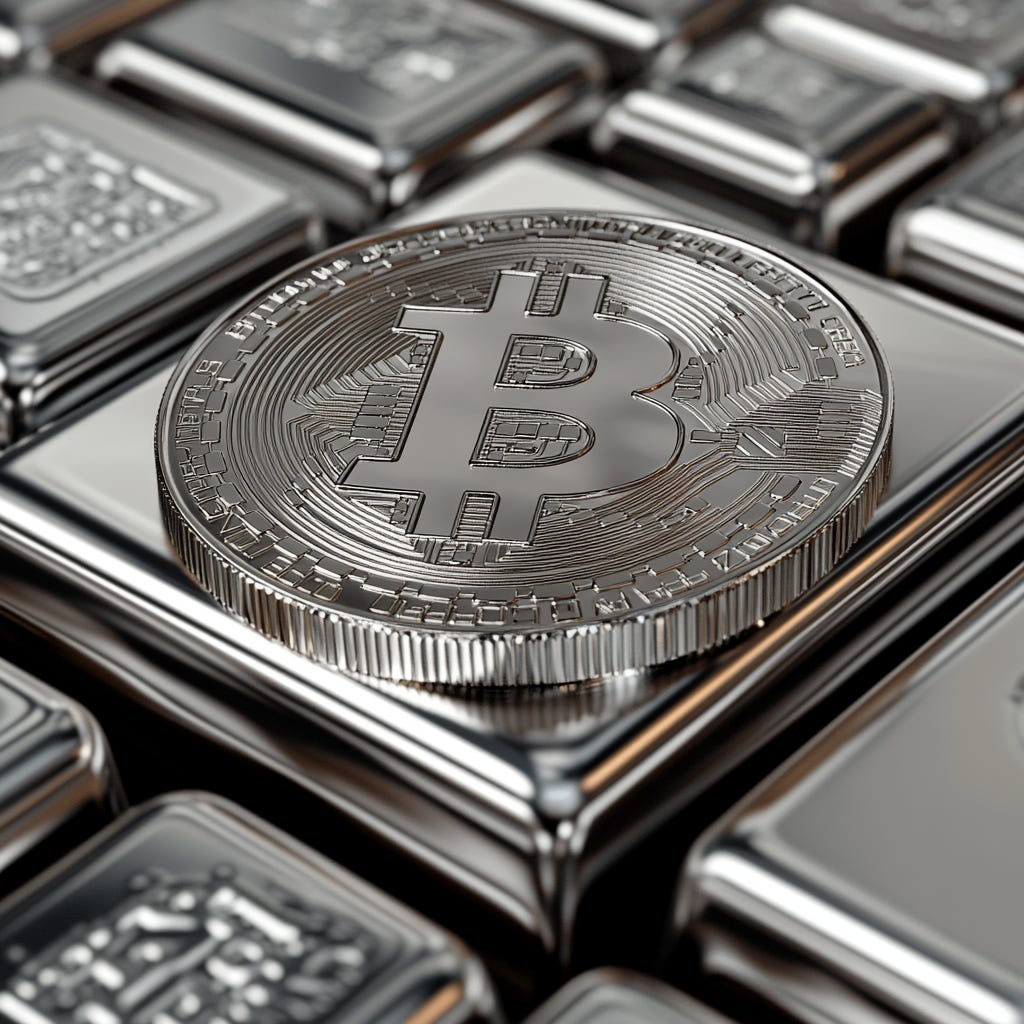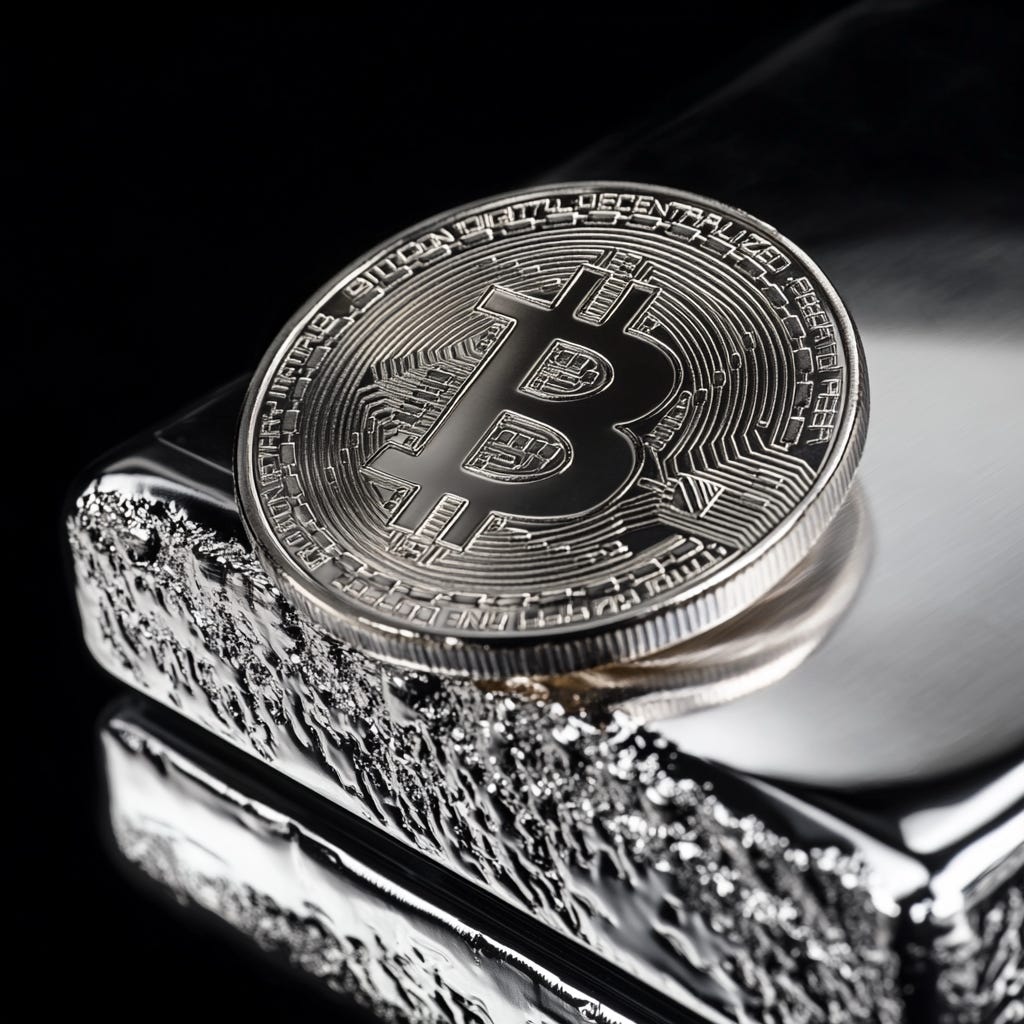Silver Over Bitcoin: A Comparative Analysis of Investment Suitability
Both silver and Bitcoin have emerged as prominent alternative assets. Silver, with its millennia-long history as a monetary and industrial metal, and Bitcoin, the decentralized digital currency that has taken the financial world by storm since its inception in 2009, are often compared for their potential to preserve wealth, hedge against inflation, and offer growth opportunities. However, when evaluating their suitability as investments, silver stands out as a more reliable, tangible, and versatile asset. This essay will explore several key factors—stability, intrinsic value, industrial utility, accessibility, and regulatory risks—to argue why silver is often a better choice than Bitcoin.
1. Stability and Historical Track Record
Silver has a history stretching back thousands of years as a store of value, medium of exchange, and investment asset. It has been used by civilizations for coinage, trade, and wealth preservation. This historical track record offers a level of stability and predictability that Bitcoin, as a relatively new and highly volatile asset, cannot yet claim.
- Silver’s Resilience Through Time: Silver has maintained its intrinsic value across centuries. Even during periods of economic turmoil, such as recessions or hyperinflation, silver has consistently provided a hedge against currency devaluation. It has proven its ability to retain purchasing power, a trait that fosters investor confidence.
- Bitcoin’s Volatility: While Bitcoin has delivered significant returns since its inception, its price has been characterized by extreme volatility. Bitcoin's value has fluctuated dramatically, experiencing both meteoric rises and catastrophic falls. For example, in 2021, Bitcoin surged to nearly $69,000 before plummeting to around $16,000 in 2022—a volatility that can deter risk-averse investors seeking stability.
Silver’s price, while not immune to fluctuations, tends to move within a more predictable range. This relative stability makes it a more attractive option for conservative investors focused on preserving capital.
2. Intrinsic Value and Tangibility
One of the most significant differences between silver and Bitcoin lies in their intrinsic value. Silver is a physical, tangible asset with inherent value derived from its unique properties and broad industrial applications. Bitcoin, on the other hand, is a purely digital asset whose value is determined solely by supply, demand, and market sentiment.
- Tangible Asset with Real-World Uses: Silver has intrinsic value due to its role in various industries, including electronics, solar energy, and medicine. Its physical existence ensures that it retains some level of value even if market sentiment wanes.
- Bitcoin’s Intangible Nature: Bitcoin exists only as code on a decentralized network. While it offers utility as a medium of exchange and store of value, it lacks any intrinsic or physical use. If confidence in the Bitcoin network were to falter, its value could theoretically drop to zero.
Silver’s tangibility provides a layer of security that Bitcoin, as a digital construct, cannot match. Investors in silver can hold the metal in their hands, offering peace of mind in uncertain times.
3. Industrial Utility and Demand
Silver’s industrial applications set it apart as a dual-purpose asset, serving both as a monetary metal and a critical component in various technologies. This dual demand helps to stabilize its price and create long-term growth opportunities.
- Technological and Industrial Applications: Silver is a vital material in the manufacturing of electronics, solar panels, batteries, and medical devices. As the world transitions to renewable energy and advanced technology, the demand for silver is expected to grow.
- Bitcoin’s Limited Utility: Bitcoin’s primary use case is as a digital currency and store of value. While its underlying blockchain technology has potential applications, Bitcoin itself lacks the broad industrial utility of silver. Its value is driven primarily by speculative investment and adoption as a financial instrument.
The industrial demand for silver provides a fundamental price floor and ensures its continued relevance in a diverse array of sectors. This makes silver a more versatile and resilient investment compared to Bitcoin.
4. Affordability and Accessibility
Silver’s lower price point relative to Bitcoin makes it a more accessible investment for a wide range of investors. This affordability is particularly advantageous for those looking to diversify their portfolios or enter the precious metals market without significant capital outlay.
- Lower Barrier to Entry: An ounce of silver typically costs a fraction of the price of a single Bitcoin. This lower cost allows investors to purchase physical silver in smaller increments, making it easier to accumulate wealth over time.
- Bitcoin’s High Price Volatility and Cost: Although Bitcoin can be purchased in fractional amounts (satoshis), its high price volatility and digital nature can deter less tech-savvy or conservative investors. Additionally, the cost of secure storage for large Bitcoin holdings—such as hardware wallets—can add to the complexity and expense of investing in the cryptocurrency.
Silver’s accessibility makes it an ideal asset for both small-scale investors and those seeking to hedge larger portfolios.
5. Regulatory Risks and Market Maturity
Another critical factor in comparing silver and Bitcoin is the regulatory environment and market maturity. While both assets face certain regulatory challenges, Bitcoin’s digital nature and association with decentralized finance (DeFi) make it more susceptible to government intervention and legal uncertainties.
- Established Market for Silver: Silver has been traded on global markets for centuries. It is well-regulated, with established mechanisms for trading, taxation, and ownership. Investors can confidently buy, sell, and store silver without fear of sudden regulatory crackdowns.
- Bitcoin’s Regulatory Uncertainty: Bitcoin operates in a regulatory gray area in many jurisdictions. Governments around the world are still grappling with how to regulate cryptocurrencies. Recent actions, such as crackdowns on cryptocurrency exchanges, mining bans in certain countries, and potential central bank digital currency (CBDC) competition, highlight the risks that Bitcoin investors face. Regulatory changes could significantly impact Bitcoin’s value and accessibility.
Silver’s established regulatory framework provides greater certainty and security for investors, making it a safer choice in uncertain times.
6. Environmental Considerations
Both silver and Bitcoin have environmental implications, but silver’s role in supporting sustainable technologies positions it more favorably in the context of environmental, social, and governance (ESG) considerations.
- Silver in Renewable Energy: Silver is a crucial component in photovoltaic cells used in solar panels, which are essential for renewable energy production. As the world transitions to cleaner energy sources, silver’s role in facilitating this shift aligns it with ESG investment trends.
- Bitcoin’s Energy Consumption: Bitcoin mining is notoriously energy-intensive. The process of validating transactions and securing the Bitcoin network requires vast amounts of computational power, much of which is powered by non-renewable energy sources. This high energy consumption has drawn criticism from environmental groups and could lead to increased regulatory scrutiny.
For environmentally conscious investors, silver offers a more ESG-friendly investment option, particularly given its critical role in green technologies.
7. Liquidity and Market Dynamics
Both silver and Bitcoin offer high levels of liquidity, but they differ in terms of market structure and behavior.
- Silver’s Physical and Paper Markets: Silver can be traded in physical form (coins and bars) and through financial instruments such as exchange-traded funds (ETFs) and futures contracts. These markets are well-established and provide ample liquidity for both small and large investors.
- Bitcoin’s Digital Market: Bitcoin is traded on cryptocurrency exchanges that operate 24/7. While this around-the-clock trading offers flexibility, it also contributes to extreme price volatility. Additionally, the market is relatively young and less regulated, which can lead to liquidity crunches and market manipulation.
Silver’s mature and regulated markets offer a more stable and predictable investment environment compared to the nascent and often chaotic cryptocurrency markets.
8. Hedge Against Inflation and Currency Devaluation
Both silver and Bitcoin are often touted as hedges against inflation and currency devaluation. However, their effectiveness in this role differs.
- Silver’s Proven Track Record: Historically, silver has served as a reliable hedge against inflation. During periods of high inflation, silver prices tend to rise as investors seek refuge in tangible assets.
- Bitcoin’s Emerging Role as a Hedge: While Bitcoin has been called “digital gold” for its potential as an inflation hedge, its short history and extreme price volatility make it a less reliable option. Bitcoin’s correlation with other risk assets, such as stocks, has also increased in recent years, raising questions about its effectiveness as a true hedge.
For investors seeking a proven inflation hedge, silver offers a time-tested solution with less volatility than Bitcoin.
The Case for Silver
When considering the suitability of silver versus Bitcoin as an investment, silver emerges as the more reliable, versatile, and accessible choice. Its intrinsic value, industrial utility, historical stability, and established regulatory framework provide a strong foundation for wealth preservation and growth. While Bitcoin offers potential for high returns, its extreme volatility, regulatory uncertainties, and lack of intrinsic value present significant risks.
Silver’s dual role as a monetary and industrial asset, coupled with its alignment with sustainable development, positions it as a compelling investment in both traditional and modern contexts. For investors seeking a balance of stability, growth potential, and long-term security, silver outshines Bitcoin as a superior investment option.


